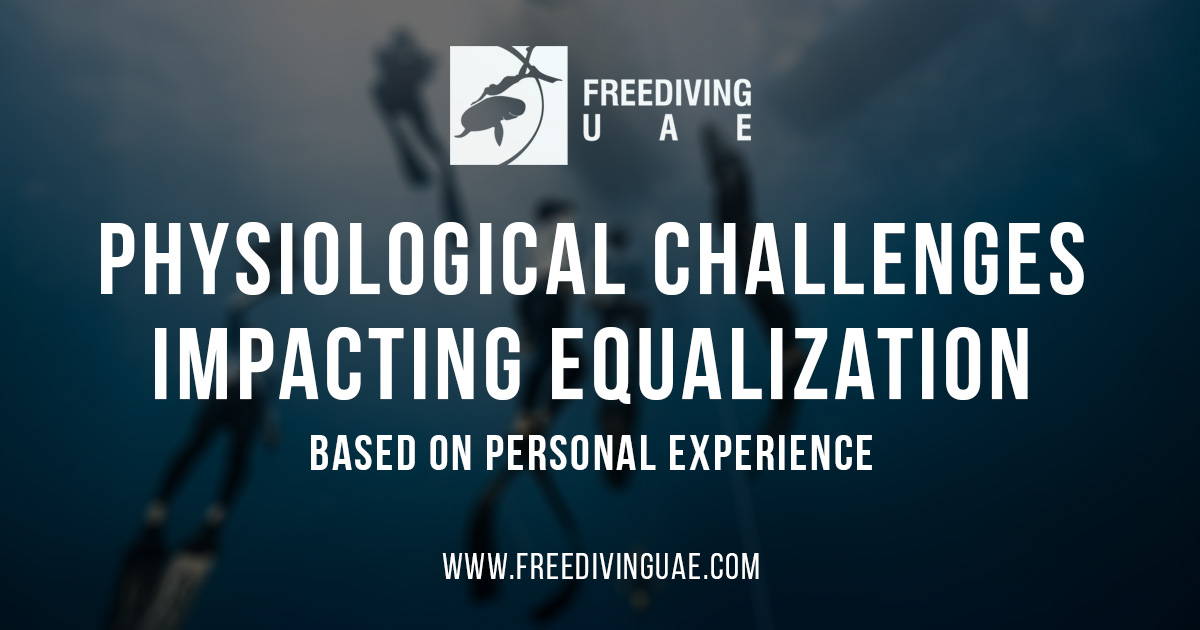Physiological challenges impacting equalization; based on personal experience.
Author: Marcin Piekarczyk
Revised and verified: Dr. Annelyse Ballin
Abstract
This paper presents a frequent topic amongst new divers, mainly freedivers which is question about physiological aspect blocking or making equalization difficult. As observed by the author many new divers who are not able to equalize very often tend to think that they have physiological problems preventing or limiting equalization. In this document it will be discussed how to understand any potential, physiological challenges and how to approach them.
The main objectives of this research are:
- To describe best practices to ensure nasal cavity is healthy and ready for freediving performance.
- To explain some, potential physiological challenges that any freediver might face.
- To present treatment and recovery plan for physiological challenges/ limitations
The main methods used for this research is author’s personal experience that has been discussed and verified by a doctor who led the case of mentioned freediver. The main source of secondary research is publicly available, scientific data and researches. Furthermore, the approach towards the treatment of physiological challenges is based on consultation with number of additional doctors such as ENT and GP physicians.
The main conclusion of this research is the fact that sometimes a diver might face physiological limitations/ challenges that will not allow him or her to progress. However, at the same time, it all depends on the scale and severity of such challenges. As presented in this case the diver was able to dive to minus 50m relatively comfortably by ensuring a daily, healthy habits routine for nasal cavity. Thus, if a person wants to continue diving recreationally or semi-professionally and challenges are not too severe there might be no need for surgical treatment. However, if a diver wants to take another step in his development and proceed with depth, then all physiological issues must be understood and tackled.
To conclude, everyone’s physiology is different, and each person needs to do his/ her examination to understand if there are any limitations. At the same time, investigation must be done after ensuring that technique used for equalization is performed well. Moreover, it must be decided if constraints are worth taken time and sometimes money to tackle them. This is individual question that must be answered based on freediving goals and aspirations.
This research has some limitations since the main argument with relevant findings is used on one example of a diver with relevant treatment applied by Dr Annelyse Ballin. Furthermore, due to lack of extensive data and relevance to freediving it was not researched more in-depth.
Equalization basics
Before reviewing physiology of equalization, it is important to present basic concepts and techniques of equalization for freediving. It is crucial and should not be forgotten that good technique is the first step for improving depth performance. Also, it is pre- requisite for further investigation if any physiological issues/ challenges impact an individual person.
There are two main equalization techniques: Valsalva and Frenzel. Due to decrease of lungs size with pressure/ depth Valsalva is becoming ineffective and risky at depth. Hence, in freediving the preferable method of equalization is Frenzel (Krack).
The below section will explain briefly Frenzel equalization as well as physiology of mouth, nose and throat.
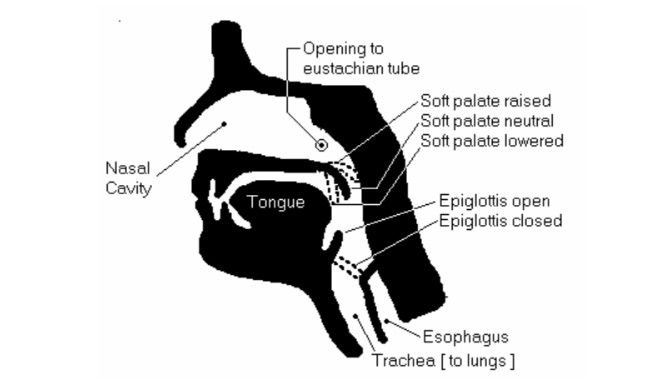
“The Definitive Guide to the Frenzel Technique”
The idea of equalization is to push air flow to eustachian tubes and into middle ear as well as other air spaces such as sinuses to balance pressure within.
What makes it different for freediving, in comparison to scuba diving is that a diver does not use diaphragm/ lungs to push the air. Instead, he or she uses the air trapped by closed epiglottis that goes to nasal cavity (ensuring soft palate is neutral) and travels to eustachian tube and middle ear to equalize it. Tongue is used as a leverage to push the air to Eustachian tube and middle ear.
However, it is important to note that all air spaces in a human body must be equalized. Hence, we cannot forget to discuss physiology of sinuses in humans’ head and nose. The picture below shows all sinuses/ airspaces in head & nose area.
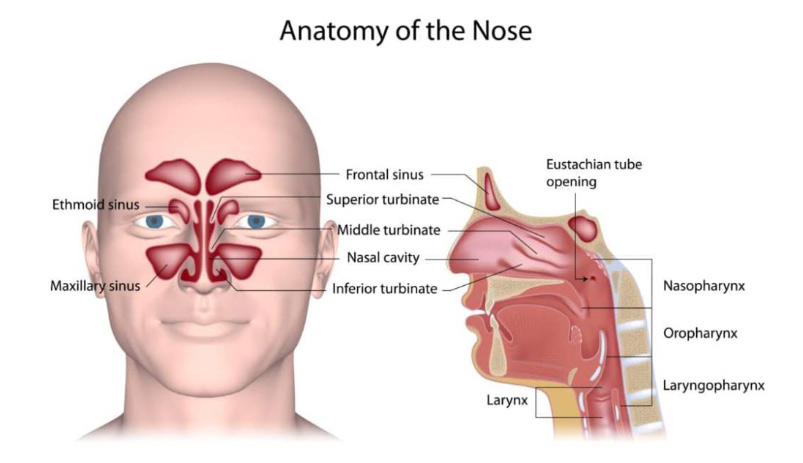
Zvaritch
The reasons why sinuses are crucial when discussing equalization is the fact that very often a diver experience pain, pressure or blood coming out from sinuses. If this is a case, then usually there might be some physiological limitations. It should be noted that everyone’s anatomy is different and what is causing limitation for one person might not be relevant for the other. Hence, human physiology might cause challenges in equalization. This is the topic that will be discussed in the next paragraph.
Physiological challenges – clinical
This section will explain a root cause of equalization issues of a particular diver who at that point was diving to minus 50m with Frenzel technique. Caveat: this diver was not using advanced Frenzel i.e., mouthfill technique.
Physical challenges that diver was facing:
- Difficulty to equalize one ear; requirement to push more air that frequently resulted in conducting reverse pack to get more air for equalization (also below residual volume, hence some instances of lung squeezes)
- Sharp pain in jaw/ teeth occurring during certain dives. Afterwards, diver was not able to submerge head underwater due to a sharp pain
- Not being able to dive more than 1-2 days in row due to nasal congestion and not being able to equalize
As a first step diver has taken number of actions to improve his preparation for diving sessions.
Change of diet
This individual has revised his holistic approach to diet and decided to take following steps to implement changes:
- Decrease/ Exclusion of diary from diet
According to some sources diary can increase production of mucus and/ or making it thicker that would cause congestion of nasal cavity. However, at the same time some sources argue that diary does not increase mucus production but can only create a feeling of thick coat in mouth due to mix of milk and saliva (Baughn).
Other sources also claim that diary can increase inflammation, especially nasal inflammation/ congestion (“Dietary Influences”)
- Decrease/ Exclusion of gluten from diet
Gluten might trigger immune reaction and increase the production of histamine in the sinus cavity. Histamine will try to protect a body from infection by causing inflammation (Marks).
- Decrease/ Exclusion of alcohol from diet (at least before diving/ training sessions/ cycles)
Limiting alcohol at least 24hours before diving. Alcohol has similar impact as gluten on human’s body. Alcohol contains histamine that is released in allergic reactions (“Alcohol Intolerance”). It is worth to mention, this not related to feeling drunk or lightheaded. The impact is caused by a body not being able to tolerate alcohol which is called metabolic disorder (McCallum).
What is more, alcohol dehydrate the body that causes Eustachian tubes to be sticky and lock up preventing a smooth equalization (“Common equalization mistakes and how to avoid them”).
- Increase of certain ingredients in diet
Turmeric – supposed to decrease inflammation in body including any inflammation in nasal cavity. Also, it is an antioxidant.
Vitamin C – antioxidant and support with muscle and body recovery.
(“Freediving and supplements”)
At the same time, this diver’s diet was already relatively healthy and suitable for freediving i.e., excluding any refined sugar, low in fat, healthy and well balanced in terms of nutritious. Hence, other aspects of healthy diet will not be discussed here as this document contains changes implemented by the diver only.
Also, the same freediver applied some habits to take better care of his nasal cavities.
New routines/ habits
- Warm/ hot inhalation of nasal cavity with eucalyptus oil (mainly a night before diving)
Studies show that eucalyptus oil inhalation reduce inflammation of nasal cavity, expel mucus and improve breathing (“Eucalyptus oil: Instant home remedy for a blocked nose”)
- Improved sleeping conditions
The diver ensured that AC is not blowing cold air directly on himself while sleeping and ensured a controlled humidity in room while sleeping (decreased humidity).
As cold air blows on a body or/and body is in humid environment, nervous system responds by producing increased mucus (“Can air conditioners cause sinus congestion?”). In the environment with lower humidity, there is greater air flow in nasal passages, hence lower obstruction (Kalning).
According to Environmental Protection Agency the most optimum humidity for sleeping is between 30-60%. As much as 50-60% is debatable by some sources, the upper threshold level is 60% (Pacheco).
Doctor recommendations and prescriptions
For a period of a couple of months, the diver was seeing different ENT doctors trying different approach that could work. Potentially, also trying to identify a root cause impacting challenges mentioned in point above.
Number of treatments and diagnosis have been confirmed with the most common being allergic reaction to dust and generic allergic reaction (seasonal). Hence, the diver has been prescribed number of different sprays as well as antibiotics to treat the allergy.
Also, one of the doctors prescribed a daily spray (extended period, around 2 months) and spray pre-diving session (decongestant). The idea for pre-dive spray was to remove inflammation and nasal congestion aiming to increase airflow of air spaces and nasal cavities.
Nothing worked in a long term except a pre-diving spray. However, that spray contains a medication that should not be used for a longer period due to the risk of medication addiction, rebound nasal congestion, and other side effects, such as high blood pressure. Furthermore, this has not tackled the root cause of the problem but only allowed to dive under medications.
It is critical to mention, that there is a risk of using sprays/ decongestants before diving. This might cause issues such as reverse block. Furthermore, some decongestants increase heart pace and might cause fatigue and tiredness when diving (“Pseudoephedrine (including Sudafed)”)
Physiological challenges – medical
The pressure inside the ears is equalized by the Eustachian tube, a tube that communicates the nose with the ears. To evaluate if discomfort during diving was caused by a Eustachian Tube dysfunction (a malfunction in the communication between the ear and the nose), a simple and fast test was done in the ENT clinic: tympanogram. The tympanogram is a test that inserts pressure in the entrance of the ear. It showed that the Eustachian tube was working properly on both ears. So, the Eustachian tube and the ears were not the root cause of the ear & equalization discomfort.
As none of the above has been successful in a long term, diver was not able to dive without discomfort, and the tympanogram was normal, it has been agreed with a doctor to conduct CT of nasal cavities and sinus. The main reason was to to review if there were any physiological challenges.
Most of ENT doctors are not keen to prescribe it and usually it is the last option reserved for very persistent patients or patients with breathing problems/ issues.
CT has shown number of changes that were not allowing smooth equalization. Starting with the first one – septum deviation. As presented on the photo from CT below, septum is clearly deviated towards one side.
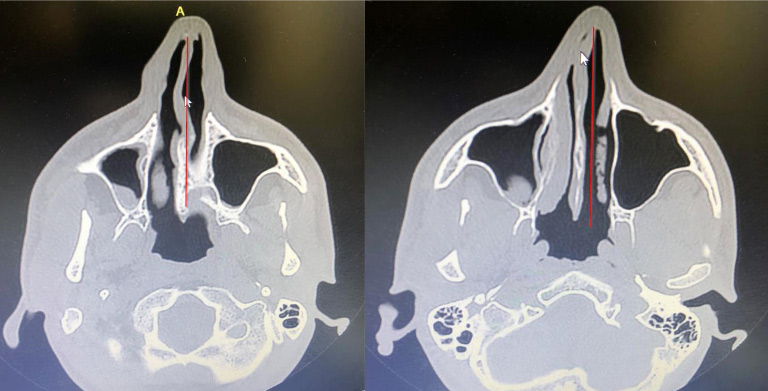
Septum deviation can have two main root causes. It can present at birth or result from trauma to the nose. In general, even deviated septum does not need to impact all individuals and might get unnoticed (also for freedivers). However, for certain people it might cause sinusitis and/or barotrauma of sinus and middle ear (“Deviated Septum”). Septum can be easily noticed during a routine, physical exam by a specialist’s doctor. It is crucial to mention that doctors are reluctant to conduct surgical intervention (septoplasty) if there are no additional reasons such as snoring, sleep apnea or breathing problems. Most of the doctors are neither divers nor experienced in diving related issues, hence correlation between septum and equalization problems might not be found at first (“Deviated Septum”).
The second, and most critical physiological problem was caused by a cyst/ polyp in Maxillary sinus.
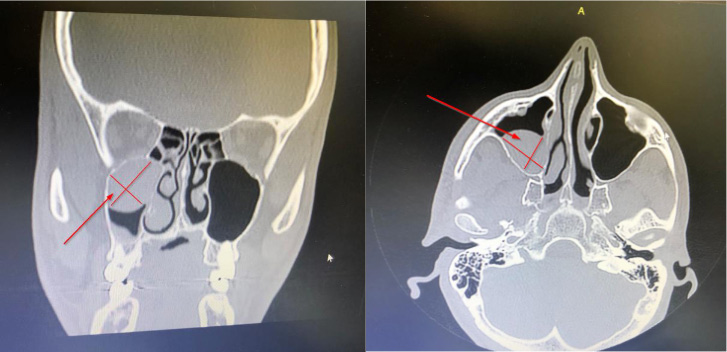
As shown on the above photos there was a significant in size cyst placed in the right Maxillary sinus. Cysts is a pocket of membranous tissue that contains fluid, air, or other substances (Delgado).
As per available research, on around 13% of sinus CTs there are visible cysts in Maxillary sinuses. Caveat: this is data refers to accidental discover of cysts for CT scans done/ requested for different reasons. Most of cases of cysts in Maxillary sinuses are asymptomatic (Hong, Cho, Roh). The maxillary sinus are located on the cheeks. However, a cyst can cause symptoms such as: facial pain over cheeks and teeth, pain in back teeth, headache, nasal obstruction, or even fever (“What is a maxillary sinus retention cyst”).
Each sinus has a small hole (called ostium) that communicates with the nose, allowing a flow of air and secretion between the nose and the sinus. The cysts presented above on photos was significantly limiting the sinus communication with the nose. Consequently, the drainage of secretion to the nose through the ostia was blocked (photo on the left), as well as the flow of air from the nose to the sinus was reduced, making it hard to the pressure be equalized on the sinus when it was necessary. (“Maxillary sinus”).
Also, due to poor sinus communication there was an extensive maxillary sinus mucosal thickening (photo on the right below), probably due to the negative pressure created inside the sinus during diving. This was the main reason for a sharp teeth pain during dives and difficult for equalization. As explained by a doctor, Maxillary sinuses are located close to jaw, hence any inflammation might impact upper jaw / teeth.
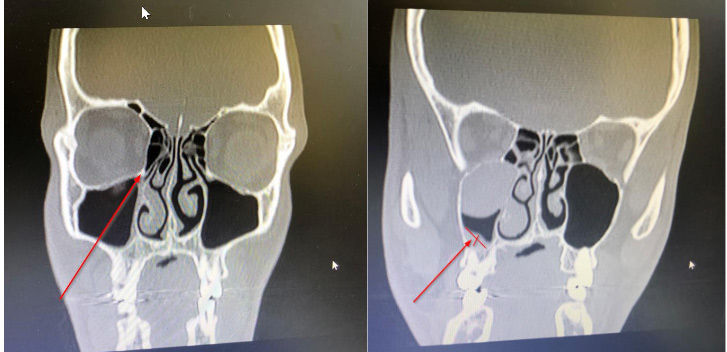
The finally, physiological reason for difficulty to equalize was enlarged inferior turbinate. Very often enlarged inferior turbinates also cause obstruction to the nose as larger turbinate blocks airflow. The inferior turbinates have almost a rectangular shape, that extends from the entrance of the nose to the back of the nose. The portion that is located on the back of the nose is very close to the entrance of the Eustachian tube. In basic words, enlarged turbinate can cause nasal congestion and difficulty to equalize the pressure of the sinus and the ears(Nall).
As you can see on the below photo, the right turbinate (right side of skull) that is highlighted in red is much smaller vs the left one.
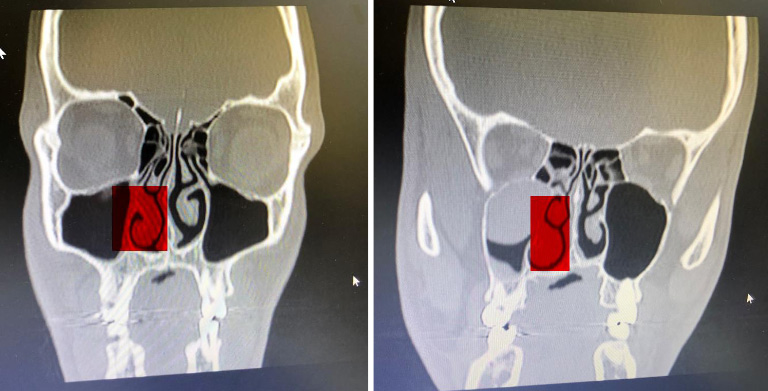
Conclusion
It is important to speak about good habits and pre-requisite steps before any cases are consulted with a doctor.
As clearly explained before, a proper technique of equalization with a good use of Frenzel method is priority and number one point to learn. If a student/ freediver is not able to correctly (on surface and in-water) use Frenzel, then any other steps i.e., understanding physiological challenges will not relevant and helpful. It has been observed that some freedivers, especially early in their development mix Frenzel and Valsalva techniques, however if they are able to go deeper, they do not allocate enough training time to take a step back and ensure the basic technique is correct.
As Diverts Alert Network (DAN) says difficulty equalizing can be symptomatic of some larger issues but only physical can determine that (“Ask DAN: What Should I Do if I Have Difficulty Equalizing?”).
Furthermore, it is crucial to ensure that a good freediving routine is part of lifestyle. In most of cases, even if physiological challenges are apparent, they are not a stopper from a comfortable and performance driven diving. At the same time, a diver without a good freediving routine might face challenges with nasal congestion due to inappropriate diet, sleeping conditions, medications, or number of other reasons. This does not mean there are significant physiological challenges.
The last and final step is seeking medical support to understand the root case. It is not easy journey as most of ENT doctors are neither diver nor experienced in diving aspects.
The example/ journey of mentioned freediver took around 8 months with number of doctor appointments with different ENTs, GPs as well as dentists. It was not mentioned before that a few ENT doctors believed that root cause was an issue with teeth (i.e., hole in a tooth). Similarly, dentist believed issues is related to ENT area. It was frustrating and time consuming for the diver to continue asking the right question as well as question doctor’s opinion by discussing with others to conduct more tests and analysis. The general recommendation it to be patient and consider it a journey. Freediving is not a sprint but a marathon. Basic techniques are crucial and all other aspects such as any challenges can be dealt with as they come.
Also, any physiological challenges might come back, re-occur again in the future, therefore as it was said before it is a journey…


